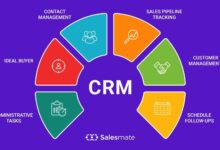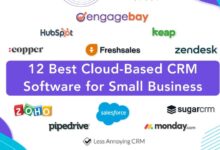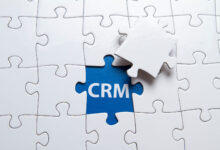CRM Software for Small Business Success
CRM Software for Small Business is no longer a luxury but a necessity. In today’s competitive landscape, effectively managing customer relationships is paramount for growth. This guide explores how the right CRM can streamline operations, boost sales, and foster stronger customer loyalty, transforming how small businesses engage with their clientele. We will delve into selecting, implementing, and optimizing CRM systems tailored to the unique needs of small enterprises, covering everything from essential features to critical security considerations.
From solopreneurs to small teams, the challenges and benefits of CRM adoption are diverse. We’ll examine these differences, providing practical advice and actionable strategies for maximizing your CRM investment. We’ll also explore different CRM types, pricing models, and crucial integrations to help you make informed decisions. The goal is to equip you with the knowledge needed to leverage CRM technology for sustainable business growth.
Defining Needs for Small Business CRM
A robust CRM system is no longer a luxury but a necessity for small businesses aiming for sustainable growth and efficient operations. Without a centralized system to manage customer interactions and data, small businesses often struggle with disorganization, lost opportunities, and ultimately, hindered profitability. This section will explore the critical needs of small businesses regarding CRM implementation, highlighting key challenges and essential features.
Key Challenges Faced by Small Businesses Without CRM Software
Small businesses lacking a CRM system frequently encounter significant operational hurdles. Three key challenges stand out: inconsistent communication leading to lost deals, difficulty tracking customer interactions and preferences, and a lack of insightful data for strategic decision-making. These issues can severely impact customer satisfaction, revenue generation, and overall business performance.
Essential Features of a Small Business CRM
A small business CRM should be user-friendly and provide a streamlined approach to managing customer relationships. Essential features include contact management (allowing for centralized storage and easy access to customer information), sales pipeline management (visualizing the sales process and identifying potential bottlenecks), communication tracking (logging all interactions – emails, calls, etc.), reporting and analytics (providing insights into sales performance and customer behavior), and basic task and appointment scheduling. These core functionalities ensure efficiency and provide valuable data-driven insights.
Comparison of CRM Needs: Solopreneurs vs. Small Teams
The CRM needs of a solopreneur differ significantly from those of a small team. A solopreneur primarily requires a simple system for contact management, task scheduling, and basic sales tracking. They might utilize a simpler, more affordable CRM solution focusing on individual client interactions. In contrast, a small team needs a more collaborative CRM, emphasizing features like shared access to customer data, workflow automation, and team communication tools to ensure everyone is on the same page and working efficiently. The level of complexity and collaboration features required directly correlates with team size and organizational structure.
Illustrative Flowchart: Typical Customer Journey in a Small Business
The following flowchart illustrates a typical customer journey for a small business using a CRM system:
[Imagine a flowchart here. It would start with a “Lead Generation” box, branching to “Initial Contact (Email/Phone),” then to “Qualification/Needs Assessment,” followed by “Proposal/Quote,” and then to “Negotiation/Closing.” A successful close leads to “Onboarding/Implementation,” then to “Ongoing Support/Maintenance,” and finally to “Repeat Business/Referral.” Unsuccessful stages would have branches leading to “Lost Opportunity” with reasons for failure noted. Each stage would ideally be linked to CRM activities like logging contact details, sending emails, scheduling calls, and updating sales pipeline status.] This visual representation clarifies the various stages involved in managing customer relationships and highlights the points where a CRM system streamlines the process.
Types of CRM Software for Small Businesses
Choosing the right CRM software can significantly impact a small business’s efficiency and growth. Understanding the different types available is crucial for making an informed decision. This section outlines three primary categories of CRM software, highlighting their functionalities, examples, and target users.
Contact Management CRMs
Contact management CRMs are foundational systems prioritizing the organization and interaction with customer data. These CRMs excel at storing contact information, managing communications, and tracking interactions. This allows businesses to maintain a centralized, easily accessible database of customer details.
Examples: Zoho CRM (offers a freemium model with robust contact management features), HubSpot CRM (free plan with basic contact management and email tracking), and Monday.com (flexible platform that includes strong contact management features within its broader project management capabilities).
Key Features: Contact details storage, communication logging (calls, emails, notes), task management related to contacts, and basic reporting on contact interactions.
Target User Profile: Small businesses with a primary focus on customer relationships and needing a simple, organized way to manage contacts and communication history. Businesses prioritizing customer service and relationship building will find this type particularly useful.
Sales Automation CRMs
Sales automation CRMs go beyond contact management by incorporating tools designed to streamline and improve the sales process. These systems often include features such as lead management, sales pipeline visualization, and sales forecasting tools. This allows sales teams to focus on closing deals rather than administrative tasks.
Examples: Pipedrive (focuses on sales pipeline management), Salesforce Sales Cloud (a more comprehensive platform with robust sales automation features, but often more expensive), and Freshsales (offers a blend of sales automation and CRM functionalities).
Key Features: Lead scoring, sales pipeline visualization, opportunity management, sales forecasting, and integration with other sales tools.
Target User Profile: Small businesses with a dedicated sales team looking to improve sales efficiency, track progress, and forecast future sales. Businesses that rely heavily on lead generation and require robust sales pipeline management will find these CRMs invaluable.
Marketing Automation CRMs
Marketing automation CRMs integrate marketing activities into the CRM system, enabling targeted campaigns, automated email sequences, and campaign performance tracking. This allows businesses to nurture leads, personalize communications, and measure marketing ROI more effectively.
Examples: HubSpot Marketing Hub (integrated with their CRM, offering a comprehensive marketing automation suite), ActiveCampaign (strong focus on email marketing and automation), and Mailchimp (while primarily an email marketing platform, it offers some CRM features).
Key Features: Email marketing automation, lead nurturing workflows, campaign management, marketing analytics, and social media integration.
Target User Profile: Small businesses focused on inbound marketing and lead nurturing. Businesses seeking to personalize their marketing efforts and track campaign performance will find this type particularly beneficial.
CRM Software Pricing Comparison
| Pricing Model | Features Included | Target Audience | Example CRM |
|---|---|---|---|
| Freemium (e.g., Zoho CRM basic plan) | Basic contact management, limited automation features | Solopreneurs, very small businesses with limited budgets | Zoho CRM |
| Subscription (e.g., Pipedrive’s essential plan) | Advanced contact management, sales pipeline visualization, basic automation | Small businesses with growing sales teams | Pipedrive |
| Subscription (e.g., HubSpot Marketing Hub Starter) | Marketing automation, email marketing, basic CRM features | Small businesses focusing on inbound marketing | HubSpot |
| Enterprise (e.g., Salesforce Sales Cloud) | Comprehensive CRM, advanced sales and marketing automation, extensive integrations | Larger businesses with complex sales and marketing needs | Salesforce |
Implementing and Using CRM Software
Successfully implementing a CRM system requires careful planning and execution. A phased approach, focusing on clear goals and user buy-in, is crucial for maximizing the return on investment and minimizing disruption to daily operations. This section outlines the key steps involved in a smooth CRM implementation and subsequent effective utilization.
CRM Implementation Steps for Small Businesses
Implementing a CRM system involves a series of sequential steps, each building upon the previous one. Failing to properly address each step can lead to problems later on. A well-defined implementation plan minimizes these risks and ensures a successful transition.
- Needs Assessment and Software Selection: This initial phase involves a thorough review of the business’s specific needs and requirements. This includes identifying key pain points the CRM should address, determining the essential features required, and selecting a CRM system that aligns with those needs and the budget. Consider factors such as scalability, integration capabilities with existing systems (e.g., accounting software), and ease of use.
- Data Migration and Cleansing: Transferring existing customer and sales data into the new CRM system is a critical step. This process should involve data cleansing to ensure accuracy and consistency. This may involve removing duplicates, correcting inconsistencies, and standardizing data formats. A well-defined data migration plan, including a backup of existing data, is crucial to prevent data loss.
- System Configuration and Customization: Once the data is migrated, the CRM system needs to be configured to meet the specific needs of the business. This may involve customizing workflows, creating custom fields, and integrating with other business applications. Thorough testing is essential to ensure the system functions correctly before full deployment.
- User Training and Adoption: Effective user training is crucial for successful CRM adoption. Training should be tailored to the different roles within the business and should focus on practical application and problem-solving. Ongoing support and readily available resources are essential to address any user questions or concerns.
- Go-Live and Ongoing Monitoring: After the training period, the CRM system can be fully deployed. However, ongoing monitoring and evaluation are essential to identify any issues and make necessary adjustments. Regular performance reviews and user feedback sessions can help optimize the system’s effectiveness.
Best Practices for Data Migration and Ensuring Data Accuracy
Accurate data is the cornerstone of a successful CRM implementation. Inaccurate or incomplete data renders the system ineffective and can lead to poor decision-making. A robust data migration strategy is essential.
Data cleansing techniques should include identifying and correcting duplicate entries, standardizing data formats (e.g., phone numbers, addresses), and verifying the accuracy of existing information. Regular data audits should be conducted to identify and address any inconsistencies that may arise over time. Consider using data validation tools to enforce data quality standards during data entry. For example, a tool could prevent the entry of an invalid email address or phone number format.
Strategies for User Training and Adoption of CRM Software
Successful CRM adoption hinges on effective user training and ongoing support. Training should not be a one-time event but an ongoing process.
Training programs should be tailored to different user roles and skill levels. Hands-on training, supplemented by online resources and documentation, is highly effective. Consider using gamification techniques to make training more engaging and encourage participation. Regular feedback sessions can help identify any training gaps or areas requiring further clarification. Incentivizing CRM usage, such as rewarding consistent data entry or achievement of sales targets, can also boost adoption rates. For instance, a small bonus for consistently using the CRM could significantly improve user engagement.
Creating a Basic Sales Pipeline in CRM Software
A well-defined sales pipeline is essential for tracking leads and managing the sales process. The specific steps involved will vary depending on the chosen CRM system, but the fundamental principles remain consistent.
- Define Stages: Identify the key stages in your sales process (e.g., Lead, Prospect, Qualified Lead, Proposal, Negotiation, Closed Won, Closed Lost). These stages should reflect your business’s unique sales cycle.
- Create Custom Fields: Add custom fields to track relevant information for each lead, such as contact details, communication history, and deal size. This allows for detailed tracking and analysis of sales performance.
- Configure Workflows: Set up automated workflows to manage the movement of leads through the pipeline. For example, automatically assign leads to sales representatives or trigger email notifications when a lead reaches a specific stage.
- Populate the Pipeline: Begin adding existing leads and contacts into the pipeline, assigning them to the appropriate stage based on their current position in the sales process.
- Monitor and Analyze: Regularly monitor the pipeline to track progress, identify bottlenecks, and make adjustments as needed. Analyze sales data to identify trends and improve sales strategies.
CRM Software and Integrations
Integrating your CRM with other business tools significantly enhances efficiency and data accuracy. By connecting different software systems, you create a streamlined workflow, eliminating manual data entry and reducing the risk of errors. This section will explore the benefits and drawbacks of such integrations, focusing on three popular examples relevant to small businesses.
Popular Software Integrations for Small Business CRMs
The strategic integration of a CRM with other business tools offers substantial advantages for small businesses. Three particularly valuable integrations are with email marketing platforms, accounting software, and e-commerce platforms. These integrations automate processes, improve data consistency, and provide a holistic view of customer interactions and financial performance.
Email Marketing Platform Integration
Integrating your CRM with an email marketing platform allows for highly targeted and personalized email campaigns. Customer data from the CRM, such as purchase history, demographics, and engagement levels, can be used to segment audiences and create tailored email messages. This leads to higher open and click-through rates, improved customer engagement, and ultimately, increased sales. However, potential drawbacks include the complexity of setting up the integration and the potential for data security concerns if not properly configured.
Accounting Software Integration
Connecting your CRM to your accounting software automates the process of tracking sales, invoices, and payments. This integration ensures that financial data is accurate and up-to-date, providing a real-time view of your business’s financial performance. The automation reduces manual data entry, minimizes errors, and streamlines the reconciliation process. Potential drawbacks include the need for compatible software and the potential for data inconsistencies if the integration isn’t properly managed.
E-commerce Platform Integration
Integrating your CRM with your e-commerce platform provides a unified view of your online customer interactions. This allows you to track customer behavior on your website, understand their purchase history, and personalize their shopping experience. The integration can automate order processing, customer support, and marketing campaigns, leading to improved customer satisfaction and increased sales. However, this integration can be technically complex to set up, and requires careful consideration of data security and privacy.
Data Flow Diagram: CRM, Email Marketing, and Accounting Software
The following diagram illustrates the data flow between a CRM system, an email marketing platform, and accounting software.
Imagine a simple diagram:
Three boxes represent the three systems: CRM, Email Marketing, and Accounting.
Arrows connect the boxes:
* A double-headed arrow connects the CRM and Email Marketing. This represents the two-way flow of customer data (e.g., email addresses, purchase history from CRM to Email Marketing for segmentation; open rates and click-through rates from Email Marketing back to CRM for analysis).
* A single-headed arrow connects the CRM and Accounting. This shows the flow of sales data (e.g., invoices, payments) from the CRM to the Accounting software for financial reporting.
Setting Up an Email Marketing Integration with a CRM System
Setting up an email marketing integration involves several steps, including obtaining API keys and utilizing appropriate authentication methods. First, you will need to create an account with both your CRM and your chosen email marketing platform. Then, locate the API key or integration settings within each platform’s settings. These keys act as unique identifiers, allowing secure communication between the systems. Common authentication methods include OAuth 2.0, which uses tokens to authorize access, and API keys with secret keys, which require careful handling to maintain security. Once the API keys are obtained, follow the integration instructions provided by your CRM and email marketing platform to link the two systems. This often involves specifying the API endpoint URLs and configuring data fields to be transferred. Remember to test the integration thoroughly to ensure data is being transferred accurately and securely. Incorrect configuration can lead to data loss or security breaches.
Measuring the Success of CRM Implementation
Implementing a CRM system is only half the battle; effectively measuring its success is crucial for maximizing return on investment (ROI) and ensuring ongoing improvement. Tracking key performance indicators (KPIs) allows businesses to understand the impact of the CRM on various aspects of their operations, from sales efficiency to customer satisfaction. Regular monitoring and analysis of these metrics enable data-driven decision-making, leading to optimized processes and enhanced business outcomes.
Successful CRM implementation is measured through a combination of quantitative and qualitative data. Quantitative data, such as sales figures and conversion rates, provides objective insights into performance. Qualitative data, obtained through customer feedback and employee surveys, offers valuable context and understanding of the user experience and overall impact. By combining both types of data, businesses gain a comprehensive picture of their CRM’s effectiveness.
Key Performance Indicators (KPIs) for CRM Success
Several key performance indicators can be tracked to gauge the success of a CRM implementation. These KPIs provide quantifiable measures of progress and areas for improvement.
- Lead Conversion Rate: This metric tracks the percentage of leads that convert into paying customers. A higher conversion rate indicates improved lead nurturing and sales processes.
- Customer Acquisition Cost (CAC): This measures the cost of acquiring a new customer. A lower CAC signifies greater efficiency in sales and marketing efforts.
- Customer Lifetime Value (CLTV): This metric predicts the total revenue generated by a customer over their entire relationship with the business. A higher CLTV demonstrates effective customer retention strategies.
- Customer Satisfaction (CSAT): Measured through surveys and feedback, CSAT reflects customer happiness with products, services, and interactions. High CSAT scores indicate a positive customer experience.
- Sales Cycle Length: This KPI tracks the time it takes to close a deal. Reducing the sales cycle length indicates improved sales efficiency and productivity.
- Average Revenue Per User (ARPU): This metric measures the average revenue generated per customer. An increase in ARPU suggests successful upselling and cross-selling initiatives.
Visualizing CRM Metrics with Reports
Data visualization is essential for effectively communicating the performance of the CRM system. Charts and graphs make complex data easily understandable, allowing for quick identification of trends and areas needing attention.
Sample Report: A sample report could include a bar chart showing lead conversion rates over time, a line graph illustrating customer satisfaction scores, and a pie chart representing the distribution of customers across different segments. These visualizations would provide a clear and concise overview of CRM performance.
For example, a bar chart showing lead conversion rates for each quarter could highlight a seasonal trend, indicating a need for adjustments in marketing strategies during low-performing periods. Similarly, a line graph showing customer satisfaction scores over time could reveal a sudden drop, prompting an investigation into the cause and implementation of corrective actions.
Improving Sales Processes and Customer Relationships with CRM Data
CRM data provides valuable insights into customer behavior, preferences, and purchase history. This information can be used to personalize marketing campaigns, improve sales processes, and strengthen customer relationships.
For instance, analyzing customer purchase history can reveal patterns that inform targeted marketing efforts. Identifying high-value customers allows for proactive engagement and personalized offers, fostering loyalty and increasing revenue. Analyzing sales cycle data can help pinpoint bottlenecks and inefficiencies, enabling process improvements and faster deal closures.
Identifying Areas for Improvement in CRM Usage
Regular analysis of CRM data helps identify areas for improvement in CRM usage and overall business processes. Low conversion rates may signal the need for improved lead qualification or sales training. Decreased customer satisfaction scores could indicate issues with product quality, customer service, or communication. By analyzing data, businesses can proactively address these issues and optimize CRM usage for maximum impact.
For example, if the data reveals a high number of abandoned shopping carts on the company website, this might indicate a problem with the checkout process or a lack of clear calls to action. Addressing these issues could significantly improve conversion rates. Similarly, a low customer retention rate might suggest a need for improved customer support or loyalty programs.
Security and Data Privacy Considerations
Protecting your customer data is paramount when using CRM software. A data breach can severely damage your reputation, lead to financial losses, and expose you to legal liabilities. Small businesses, often lacking extensive IT resources, are particularly vulnerable. Therefore, understanding and implementing robust security measures is crucial for maintaining customer trust and complying with relevant regulations.
Implementing appropriate security measures safeguards sensitive customer information, preventing unauthorized access, use, disclosure, disruption, modification, or destruction. This proactive approach not only mitigates risks but also demonstrates a commitment to ethical data handling, fostering stronger customer relationships.
Data Security Measures for Small Businesses
Small businesses can effectively protect customer data within their CRM by employing several key security measures. These measures are not overly complex and can be implemented with relatively little technical expertise.
- Strong Passwords and Multi-Factor Authentication (MFA): Implementing strong, unique passwords for each user and enabling MFA adds an extra layer of security, making it significantly harder for unauthorized individuals to gain access. MFA typically involves requiring a second form of verification, such as a code sent to a mobile phone or email, in addition to a password.
- Regular Software Updates and Patches: Keeping the CRM software and all related systems up-to-date with the latest security patches is crucial. These updates often address vulnerabilities that could be exploited by malicious actors.
- Access Control and Permissions: Implementing a system of granular access control ensures that only authorized personnel have access to specific data within the CRM. This minimizes the risk of data breaches caused by accidental or malicious actions by employees.
- Data Encryption: Encrypting data both in transit (while being transmitted) and at rest (while stored) protects it from unauthorized access even if a breach occurs. Encryption renders the data unreadable without the appropriate decryption key.
- Regular Data Backups: Regularly backing up the CRM data to a secure offsite location allows for quick recovery in the event of a data loss incident, minimizing business disruption.
- Security Awareness Training for Employees: Educating employees about phishing scams, malware, and other cybersecurity threats is essential. Regular training reinforces best practices and helps prevent human error, a common cause of security breaches.
Compliance Requirements for Customer Data
Several regulations govern the collection, storage, and handling of customer data. Compliance is not merely a legal obligation; it also builds customer trust and reinforces your commitment to data privacy.
- GDPR (General Data Protection Regulation): The GDPR, applicable in the European Union, sets strict rules for processing personal data. It requires businesses to obtain explicit consent for data collection, provide individuals with access to their data, and implement appropriate security measures to protect it. Failure to comply can result in significant fines.
- CCPA (California Consumer Privacy Act): The CCPA, applicable in California, grants consumers certain rights regarding their personal data, including the right to know what data is collected, the right to delete data, and the right to opt-out of the sale of their data. Businesses must comply with these rights and implement appropriate security measures.
Best Practices for Password Management and User Access
Strong password management and controlled user access are cornerstones of CRM security.
- Strong Passwords: Passwords should be long (at least 12 characters), complex (including uppercase and lowercase letters, numbers, and symbols), and unique to each account. Password managers can help generate and securely store strong passwords.
- Regular Password Changes: Regularly changing passwords, particularly for administrative accounts, reduces the risk of unauthorized access if a password is compromised.
- Least Privilege Principle: Grant users only the access they need to perform their job duties. Avoid granting unnecessary administrative privileges.
- Role-Based Access Control (RBAC): Implement RBAC to define specific roles within the organization and assign permissions based on those roles. This simplifies access management and ensures that users only have access to the data relevant to their roles.
Final Wrap-Up
Ultimately, implementing the right CRM Software for Small Business represents a strategic investment in growth and efficiency. By carefully considering your specific needs, selecting the appropriate software, and diligently implementing best practices, small businesses can unlock significant potential. This guide has provided a framework for navigating this process, empowering you to leverage CRM technology to build stronger customer relationships, streamline operations, and ultimately achieve greater success. Remember that continuous monitoring and adaptation are key to maximizing your CRM’s effectiveness.





